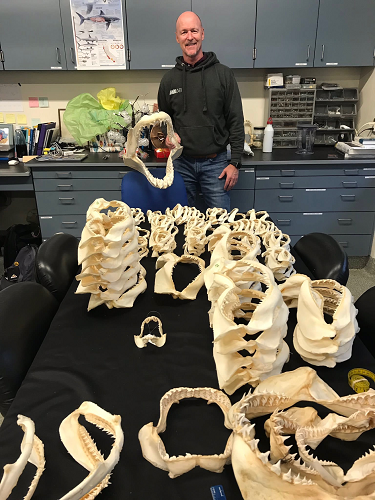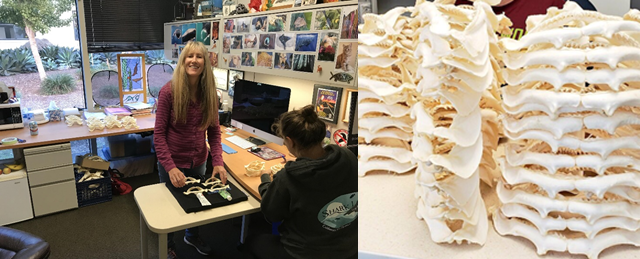Shark Jaws Program

In Summer 2018, the U.S. Department of Fish and Wildlife received a shipment of ~6,000 jaws prepared for sale in curio markets in the U.S. However, with help from the Shark Lab, Fish and Wildlife officers were able to identify numerous protected species in the shipment, which resulted in a forfeiture of the shipment by the exporters. Rather than seeing the forfeited jaws destroyed, Dr. Chris Lowe agreed to take possession of the jaws and to distribute them for education purposes.
Shark Lab students along with Dr. Gwen Goodmanlowe and Mark Harris measured and identified over 6600 jaws by species and sex. Among the 21 species identified, 4 were CITES (Convention on International Trade in Endangered Species) protected. About 4,000 jaws were from one species alone, the data-deficient spot-tail shark (Carcharhinus sorrah), and 1000 were from the near-threatened black-tip shark (Carcharhinus limbatus). We also found the critically endangered scalloped hammerhead shark (Sphyrna lewini), two endangered species, the pelagic thresher and the dusky shark (Alopias pelagicus and Carcharhinus obscurus, respectively), and other seven species in vulnerable state according to the IUCN Red List (International Union for Conservation of Nature).
The Shark Lab has developed curriculum to go with the jaws to help foster an interest in STEM fields.

3D Model - Shark Jaws
Jaws Made Out Of Cartilage
- Let's first remember that sharks' skeleton is made out of cartilage, a substance less dense and more flexible than bone. We, humans, have this flexible cartilage in our ears and the tip of our nose. However, Shark cartilage is slightly denser and stiffer as it is made of crystal minerals (as calcium phosphate) and collagen among other proteins. This makes shark's jaws slightly flexible for a better grab of prey, and still stiff enough for a better biting support through the dense bones or skin of their prey.
- Notice that in cleaned and dried shark jaws, as the cartilage loses water and collagen, the cartilage of the jaw becomes stiff and hardened, which is very different from its natural healthy state.
Jaws Attachment To The Braincase
- Interestingly, modern sharks' jaws have a loose attachment to the cranium when compared to earliest sharks. Thus, the upper and lower jaw of more advanced modern sharks and rays are attached to the cartilage skull (chondrocranium) by a set of ligaments. This loose attachment allows the upper jaw to be distended outwards and a wider separation with the lower jaw for a better grip of prey.
- The muscles attached to the jaw (e.g. their contraction and relaxation) control the direction of movement of the jaw. The contraction of specific muscles (e.g. preorbitalis muscle and levator palatoquadrate) forces the upper jaw outward and the lower jaw downward, allowing the protrusion of the jaw and an expansive opening of the mouth. Other muscles (quadratomandibularis) allow the buccal cavity to close when they contract causing the retract of the upper jaw and rising of the lower jaw until the two jaws come together.
- Most large predatory sharks seize their prey with an open-mouthed strike, followed by strong and rapid head shaking to help saw and tear off prey tissue with their teeth.
Kinematics And Mechanics Of Bite
- Even though sharks have jaws made of flexible cartilage that are capable of detaching from the skull (chondrocranium), powerful muscles attach the jaws to the skull and allows them to exert high biting force.
- The bite force of some large predatory species, such as the white shark (Carcharodon carcharias), the bull shark (Carcharhinus leucas), and the great hammerhead shark (Sphyrna mokarran) have some of the highest bite forces measured among vertebrates and can produce bite forces of over 2000 Newtons.
- Sharks that feed on hard shelled prey items (e.g., crabs, snails, clams), such as the horn shark (Heterodontus francisci), are also characterized for having high bite forces (~128 Newtons); yet, narrow and pointed teeth to penetrate their hard prey.
- Contrary, other sharks that feed on fast moving fish of relative soft tissue, such as the blacktip shark (Carcharhinus limbatus), are more bite-speed efficient than bite-force efficient.
What About Sharks' Teeth?
- A layer of teeth is embedded in the jaw by connective tissue and aligned next to each other in rows in either side of the symphysis (e.g., the adjoining point between the right and left jaw), which divides the upper and lower jaw into 4 quadrants. Most shark species have between 20 and 30 functional teeth per row for each quadrant. However, the number of tooth rows exposed outside of the gum tissue can vary from 1 row of teeth per jaw in some rays to as many as 300 tiny rows in the planktivorous whale sharks.
- Functional teeth are the very front teeth in the sharks' mouth; however, there is always a replacement right behind that functional row. Several rows of new teeth are being formed below the gum line and erupt from the gum and the old functional row fall out during feeding or are just sloughed off. This is called synchronous serial tooth replacement. The rate of tooth replacement can vary among species. This is because teeth lost depends on the species diet preferences on either hard or soft preys. Given that sharks' diet can vary by age and sex, the rate of teeth replacement will be affected by these factors as well. For instance, leopard sharks (Triakis semifasciata) can replace a row every ~12 days, horn sharks (Heterodontus francisci) every ~28 days, and lemon sharks (Negaprion brevirostris) every ~ 10 days. As new replaced teeth are sharper than previous functional teeth, a significant lower bite force may be required to penetrate the prey tissue.
- In addition, the great diversity of teeth shape of modern sharks is primarily influenced by the shark's diet. For instance, long and slender teeth with pointed cusps and smooth sides allow stabbing and gripping the prey, while triangular teeth with serrated sides allow sawing off chunks of tissue with ease. For instance, the broad and serrated teeth of the white shark (Carcharodon carcharias) or tiger shark (Galeocerdo cuvier) is characteristic in species that gouge chunks of flesh of large denser prey, while the long and pointed teeth in the sand tiger shark (Carcharias taurus) or shortfin mako (Isurus oxyrinchus) is characteristic of piscivorous sharks that require stab and tearing softer skinned fishes
Scanned Juvenile White Sharks
You can 3D print your own white shark jaws from the CAD file we have provided here. Since the 3D imaging of the frozen jaws was not perfect, we have digitally “cleaned” up the jaws and teeth and reinserted them into the jaw. If you have the right printer, you may be able to print the teeth in a different material if you choose (e.g., vinyl) and print the jaw in silicon to give it a more “natural” flexibility. Note the hinge at the corners of the mouth is flex joint as well as in the joint in the center of the upper and lower jaw (symphysis). You should also be able to scale the jaw you print various sizes, but remember this is from a juvenile white shark (6.5 ft in length) so the dentition will only represent that of a juvenile "fish-eating" white shark.
CAD file for Model Shark Jaw - please email sharklab@csulb.edu
Juvenile White Shark Jaw Animations
Serial Synchronous Tooth Replacement
This animation shows serial synchronous tooth replacement using the white shark jaw as an example. Note that the front functional teeth may just slough off as newer teeth pointed back in the mouth rotate forward. As functional teeth slough off, new teeth would be erupting from the gum, filling the position of the tooth row that preceded. Typically, there are 2-3 rows of teeth exposed at a time in white sharks
VIDEO: Serial Tooth Loss
Jaw Bite Mechanics
When kids are holding a set of dried shark jaws, they often struggle to understand that the jaw is made of more flexible cartilage and has multiple hinges and joints that enable it to flex and use serrated teeth for the purpose of sawing. We have developed these animations to help you understand how and where the jaws flex when a shark is biting and object. Hopefully, this will help kids better understand some of the cool physics and engineering principles between the cartilaginous shark jaw.
This animation shows a frontal, side, and inner view of the shark jaw when biting.
VIDEO: Bite and Saw
Jaw Bite Mechanics
When kids are holding a set of dried shark jaws, they often struggle to understand that the jaw is made of more flexible cartilage and has multiple hinges and joints that enable it to flex and use serrated teeth for the purpose of sawing. We have developed these animations to help you understand how and where the jaws flex when a shark is biting and object. Hopefully, this will help kids better understand some of the cool physics and engineering principles between the cartilaginous shark jaw.
This animation shows a frontal, side, and inner view of the shark jaw when biting.
VIDEO: Asymmetrical Bite
References
- Bergman, J. N., Lajeunesse, M. J., & Motta, P. J. (2017). Teeth penetration force of the tiger shark Galeocerdo cuvier and sandbar shark Carcharhinus plumbeus. Journal of Fish Biology, 91(2), 460-472. doi: 10.1111/jfb.13351
- Huber, D. R., Eason, T. G., Hueter, R. E., & Motta, P. J. (2005). Analysis of the bite force and mechanical design of the feeding mechanism of the durophagous horn shark; Heterodontus francisci. Journal of Experimental Biology, 208(18), 3553. doi: 10.1242/jeb.01816
- Klimley, A. P. (2013). The biology of sharks and rays. University of Chicago Press.
- Motta, P. J., & Huber, D. R. (2004). Prey capture behavior and feeding mechanics of elasmobranchs. Biology of sharks and their relatives, 165-202.
Jaws were cleaned and prepared by Patrick Rex and scanned at the CSULB Innovation Space. This 3D scan file was used for the creation of the 3D animations by Ellen Lucchesi and Thomas Watabayashi – CSULB BA Fine Arts in Animation.
Jaws Curriculum
Download the Jaws Curriculum for your school!
- Into to Sharks Unit Map (PDF)
- Lesson 1 - Scientist Shark Dive (PDF)
- Shark Dive Data Sheet (PDF)
- Grey Reef Shark (C. amblyrhynchos) fact sheet (PDF)
- Pigeye Shark (C. amboinensis) fact sheet (PDF)
- Spinner Shark (C. brevipinna) fact sheet (PDF)
- Silky Shark (C. falciformis) fact sheet (PDF)
- Blacktip Shark (C. limbatus) fact sheet (PDF)
- Hardnose Shark (C. macloti) fact sheet (PDF)
- Dusky Shark (C. obscurus) fact sheet (PDF)
- Sandbar Shark (C. plumbeus) fact sheet (PDF)
- Spottail Shark (C. sorrah) fact sheet (PDF)
- Scalloped Hammerhead Shark (S. lewini) fact sheet (PDF)
- Smooth Hammerhead Shark (S. zygaena) fact sheet (PDF)
- Pelagic Thresher (A. pelagicus) fact sheet (PDF)
- Whitetip Reef Shark (T. obesus) fact sheet (PDF)
- Tiger Shark (G. cuvier) fact sheet (PDF)
- Lesson 2 - Population Dynamics Activity (PDF)
- Lesson 3 - Shark Jaws and Teeth (PDF)





